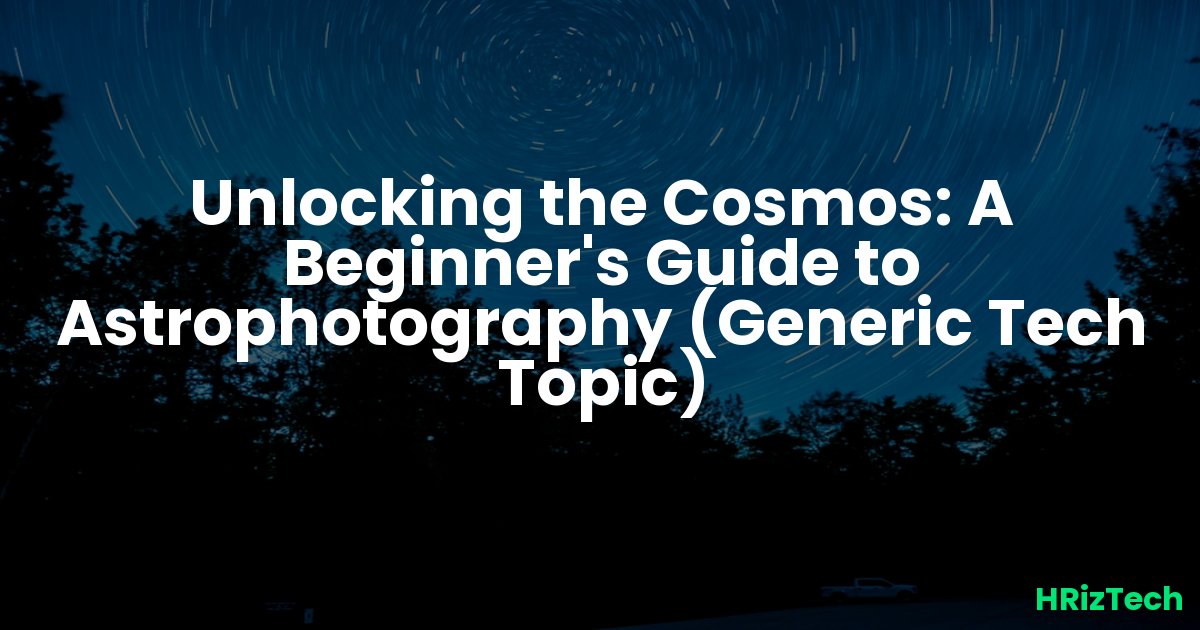Unlocking the Cosmos: A Beginner's Guide to Astrophotography (Generic Tech Topic)

Unlocking the Cosmos: A Beginner's Guide to Astrophotography (Generic Tech Topic)
Ever looked up at a star-studded night sky and wished you could capture its breathtaking beauty? You're not alone! Astrophotography, the art of photographing celestial objects, is becoming increasingly popular, but it can feel intimidating for beginners. This guide will demystify the process, helping you take stunning images of the cosmos, even with basic equipment. We'll explore how advancements in Generic Tech Topic, like improved image sensors and AI-powered software, are making astrophotography more accessible than ever before.Getting Started: Essential Equipment for Astrophotography
You don't need a massive telescope and a fortune to start astrophotography. A good starting point involves a DSLR or mirrorless camera with a manual mode, a sturdy tripod, and a wide-angle lens.
Why these? A DSLR or mirrorless camera gives you control over settings crucial for capturing low-light images. The tripod keeps your camera steady during long exposures, essential for capturing faint celestial objects. A wide-angle lens allows you to capture a larger portion of the night sky.
Choosing the Right Camera and Lens
Many cameras work well for astrophotography. Consider features like high ISO performance (ability to shoot in low light) and a large sensor size for better image quality. A wide-angle lens (e.g., 14mm, 24mm, or 35mm) is ideal for capturing expansive night sky views.
Mastering the Basics: Camera Settings and Techniques
Astrophotography requires understanding your camera's settings. The key is to maximize light gathering while minimizing noise (graininess) in your images.
How do I start? Begin by shooting in manual mode (M). Set your ISO to a relatively high value (experiment to find the sweet spot for your camera, usually between 800-3200), your aperture to its widest setting (lowest f-number), and your shutter speed to a value that avoids overexposure (start with around 20-30 seconds and adjust based on the brightness of the sky).
Focusing and Composition
Focusing in the dark can be tricky. Use live view, zoom in on a bright star, and manually adjust focus until the star appears as a pinpoint of light. Composition involves planning your shot. Consider including foreground elements for a more interesting image.
Advanced Techniques: Stacking and Post-Processing
To capture truly stunning images of faint objects like nebulae and galaxies, you'll likely need to use image stacking. This involves taking many short exposures and combining them using specialized software to reduce noise and increase detail.
What software should I use? Popular options include DeepSkyStacker and Sequator. Generic Tech Topic plays a significant role here, with AI-powered tools now assisting in automating stacking and noise reduction. A 2025 Gartner report predicts increased use of AI in image processing, making astrophotography more accessible.
Post-Processing with Software
Once you've stacked your images, you'll need to post-process them using software like Photoshop or dedicated astrophotography software such as PixInsight. This involves adjusting brightness, contrast, color, and removing noise to bring out the best details in your images. This step is where your creativity shines!
Overcoming Common Challenges in Astrophotography
Light pollution is a major hurdle for astrophotography. City lights wash out the faint light from celestial objects. To mitigate this, shoot from dark locations away from city lights, or use light pollution filters.
What are other challenges? Another common challenge is camera shake. Use a sturdy tripod and consider using a remote shutter release to avoid touching the camera during long exposures. Also, proper image calibration is critical for eliminating noise and artifacts that can ruin your final image.
Troubleshooting Tips
- Camera shake: Use a sturdy tripod, remote shutter release, and possibly a timer.
- Light pollution: Shoot in dark locations or use light pollution filters.
- Focusing issues: Use live view and zoom in on a bright star for accurate focusing.
- Software issues: Consult online tutorials and forums for support.
The Future of Astrophotography: Generic Tech Topic and Beyond
The field of astrophotography is constantly evolving. Advancements in Generic Tech Topic, such as improved image sensors with higher sensitivity and AI-powered image processing tools, are making it easier than ever to capture breathtaking images of the cosmos. We're also seeing the rise of smart telescopes that automate many aspects of the process, simplifying the experience for beginners.
What's next? Cybersecurity is also becoming increasingly important, as online platforms for sharing and storing astrophotography data need robust protection against threats. A 2025 Cybersecurity report highlights this growing concern.
Generic Tech Topic is transforming how we interact with and explore the universe. This means more accessible and powerful tools for capturing the beauty of the cosmos. The future looks bright (pun intended!) for astrophotography enthusiasts.
Have you ever tried astrophotography? What were your biggest challenges?
What’s your favorite AI tool for image processing? Share below!
Comments
No comments yet. Be the first to comment!